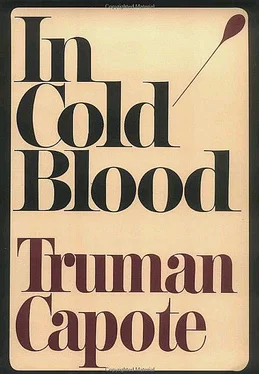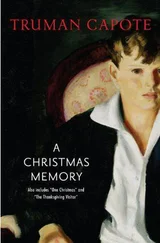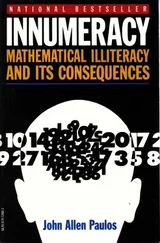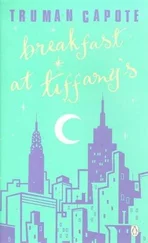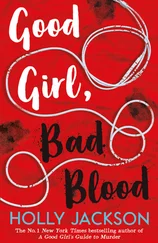The thought, acutely painful, passed, for Dick, with a wink and a playful jab, said, “Sure, honey. I’m with you. All the way.”
It was three in the morning, and the telephone rang again. Not that the hour mattered. Al Dewey was wide awake anyway, and so were Marie and their sons, nine-year-old Paul and twelve-year-old Alvin Adams Dewey, Jr. For who could sleep in a house—a modest one-story house—where all night the telephone had been sounding every few minutes? As he got out of bed, Dewey promised his wife, “This time I’ll leave it off the hook.” But it was not a promise he dared keep. True, many of the calls came from news-hunting journalists, or would-be humorists, or theorists (“Al? Listen, fella, I’ve got this deal figured. It’s suicide and murder. I happen to know Herb was in a bad way financially. He was spread pretty thin. So what does he do? He takes out this big insurance policy, shoots Bonnie and the kids, and kills himself with a bomb. A hand grenade stuffed with buckshot”), or anonymous persons with poison-pen minds (“Know them Ls? Foreigners? Don’t work? Give parties? Serve cocktails? Where’s the money come from? Wouldn’t surprise me a darn if they ain’t at the roots of this Clutter trouble”), or nervous ladies alarmed by the gossip going around, rumors that knew neither ceiling nor cellar (“Alvin, now, I’ve known you since you were a boy. And I want you to tell me straight out whether it’s so. I loved and respected Mr. Clutter, and I refuse to believe that that man, that Christian—I refuse to believe he was chasing after women …”).
But most of those who telephoned were responsible citizens wanting to be helpful (“I wonder if you’ve interviewed Nancy’s friend, Sue Kidwell? I was talking to the child, and she said something that struck me. She said the last time she ever spoke to Nancy, Nancy told her Mr. Clutter was in a real bad mood. Had been the past three weeks. That she thought he was very worried about something, so worried he’d taken to smoking cigarettes…”). Either that or the callers were people officially concerned—law officers and sheriffs from other parts of the state (“This may be something, may not, but a bartender here says he over heard two fellows discussing the case in terms made it sound like they had a lot to do with it…”). And while none of these conversations had as yet done more than make extra work for the investigators, it was always possible that the next one might be, as Dewey put it, “the break that brings down the curtain.”
On answering the present call, Dewey immediately heard “I want to confess.”
He said, “To whom am I speaking, please?”
The caller, a man, repeated his original assertion, and added, “I did it. I killed them all.”
“Yes,” said Dewey. “Now, if I could have your name and address…”
“Oh, no, you don’t,” said the man, his voice thick with inebriated indignation. “I’m not going to tell you anything. Not till I get the reward. You send the reward, then I’ll tell you who I am. That’s final.”
Dewey went back to bed. “No, honey,” he said. “Nothing important. Just another drunk.”
“What did he want?”
“Wanted to confess. Provided we sent the reward first.” (Akansas paper, the Hutchinson News, had offered a thousand dollars for information leading to the solution of the crime.)
“Alvin, are you lighting another cigarette? Honestly, Alvin, can’t you at least try to sleep?”
He was too tense to sleep, even if the telephone could be silenced—too fretful and frustrated. None of his “leads” had led anywhere, except, perhaps, down a blind alley toward the blankest of walls. Bobby Rupp? The polygraph machine had eliminated Bobby. And Mr. Smith, the farmer who tied rope knots identical with those used by the murderer—he, too, was a discarded suspect, having established that on the night of the crime he’d been “off in Oklahoma.” Which left the Johns, father and son, but they had also submitted provable alibis. “So,” to quote Harold Nye, “it all adds up to a nice round number. Zero.” Even the hunt for the grave of Nancy’s cat had come to nothing.
Nevertheless, there had been one or two meaningful developments. First, while sorting Nancy’s clothes, Mrs. Elaine Selsor, her aunt, had found tucked in the toe of a shoe a gold wristwatch. Second, accompanied by a K.B.I. agent, Mrs. Helm had explored every room at River Valley Farm, toured the house in the expectation that she might notice something awry or absent, and she had. It happened in Kenyon’s room. Mrs. Helm looked and looked, paced round and round the room with pursed lips, touching this and that—Kenyon’s old baseball mitt, Kenyon’s mud-spattered work boots, his pathetic abandoned spectacles. All the while she kept whispering, “Something here is wrong, I feel it, I know it, but I don’t know what it is.” And then she did know. “It’s the radio! Where is Kenyon’s little radio?”
Taken together, these discoveries forced Dewey to consider again the possibility of “plain robbery” as a motive. Surely that watch had not tumbled into Nancy’s shoe by accident? She must, lying there in the dark, have heard sounds—footfalls, perhaps voices—that led her to suppose thieves were in the house, and so believing must have hurriedly hidden the watch, a gift from her father that she treasured. As for the radio, a gray portable made by Zenith—no doubt about it, the radio was gone. All the same, Dewey could not accept the theory that the family had been slaughtered for paltry profit—“a few dollars and a radio. “ To accept it would obliterate his image of the killer—or, rather, killers. He and his associates had definitely decided to pluralize the term. The expert execution of the crimes was proof enough that at least one of the pair commanded an immoderate amount of cool-headed slyness, and was— must be—a person too clever to have done such a deed without calculated motive. Then, too, Dewey had become aware of several particulars that reinforced his conviction that at least one of the murderers was emotionally involved with the victims, and felt for them, even as he destroyed them, a certain twisted tenderness. How else explain the mattress box?
The business of the mattress box was one of the things that most tantalized Dewey. Why had the murderers taken the trouble to move the box from the far end of the basement room and lay it on the floor in front of the furnace, unless the intention had been to make Mr. Clutter more comfortable—to provide him, while he contemplated the approaching knife, with a couch less rigid than cold cement? And in studying the death-scene photographs Dewey had distinguished other details that seemed to support his notion of a murderer now and again moved by considerate impulses. “Or”—he could never quite find the word he wanted—“something fussy. And soft. Those bedcovers. Now, what kind of person would do that—tie up two women, the way Bonnie and the girl were tied, and then draw up the bedcovers, tuck them in, like sweet dreams and good night? Or the pillow under Kenyon’s head. At first I thought maybe the pillow was put there to make his head a simpler target. Now I think, No, it was done for the same reason the mattress box was spread on the floor—to make the victim more comfortable.”
But speculation such as these, though they absorbed Dewey, did not gratify him or give him a sense of “getting somewhere.” A case was seldom solved by “fancy theories”; he put his faith in facts—“sweated for and sworn to.” The quantity of facts to be sought and sifted, and the agenda planned to obtain them, promised perspiration a plenty, entailing, as it did, the tracking down, the “checking out,” of hundreds of people, among them all former River Valley Farm employees, friends and family, anyone with whom Mr. Clutter had done business, much or little—a tortoise crawl into the past. For, as Dewey had told his team, “we have to keep going till we know the Clutters better than they ever knew themselves. Until we see the connection between what we found last Sunday morning and something that happened maybe five years ago. The link. Got to be one. Got to.”
Читать дальше
